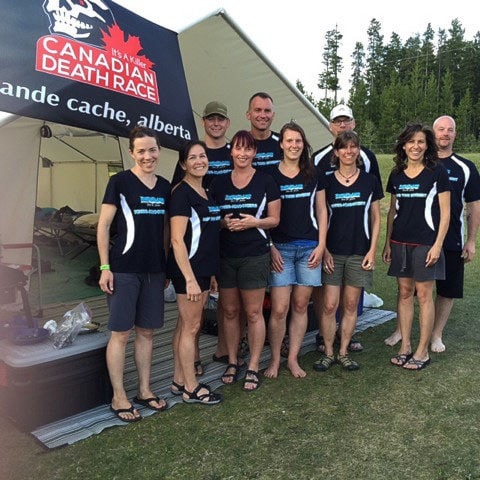The name alone says that the “Canadian Death Race” isn’t going to be a stroll in the park. Covering 125km, the course starts and ends on a 4,200 foot plateau, crosses three mountain summits, and includes more than 17,000 feet of elevation change and a major river crossing. The ultra-marathon race takes place every August long weekend in Grande Cache, Alberta, with competitors—either solo or as part of a relay team—given 24 hours to complete the course.
“I’m not a soloist, nor do I want to be,” says Tim Dunkley of Fort St. James. Instead he ran as part of one of two teams of five from the Fort who took part, sponsored by Northland Automotive: Northland’s Rapid Thigh Movement (Cheryl Hodder, Tim Dunkley, Yvonne Gilbert, Lisa Spingle, and Chris Greenaway) and Northland’s Knee Knockers (Rhona Boyd, Jim Burck, Jasmine Lakusta, Anthony Boyd, and Tanya Kruisselbrink).
Five of the ten Fort St. James runners were rookies doing their first Death Race, while the other five have taken part between two and five times each. The course is divided into five segments, each of a different length and with varying terrain, and each team member ran a different segment. Both teams were thrilled with their finishes, with Rapid Thigh Movement coming in 8th out of 162 teams in a time of 14 hours and 17 minutes, and the Knee Knockers winding up at 17th overall in 15 hours and 8 minutes.
Dunkley says the recruitment for this year’s teams started last December, with anyone interested attending a potluck dinner and watching a video about the race. Once enough people had signed up, the teams registered, and training on local trails began.
“We’re fortunate to have a fantastic network of trails at our disposal for trail runners and mountain bikers,” said Dunkley. “And a huge shout-out to the volunteers who built, and continue to maintain, this fantastic network.” The runners trained frequently on Mt. Pope, which Dunkley said was great preparation for the Death Race. “It’s rough, rocky, uneven, root-laden terrain that’s very similar to what you encounter on the Death Race,” he says. “And you have to be able to train uphill and downhill. We couldn’t ask for a better training area.” The runners often trained together, challenging themselves and each other.
One of the initial registrants, Sandra Sulyma, had to withdraw before the race because of a nagging injury she couldn’t shake. She was replaced by Jasmine Lakusta, but was determined to experience the event, so went with the teams in order to take in the whole experience. Dunkley says her help was invaluable, and that both teams can’t thank her enough for her help in shuttling and feeding the runners and looking after the kids, as well as for all her help around camp. “Hopefully she’ll be able to take part in the race next year.”
She’s not the only one thinking about next year; the ten runners from the Fort who took part all want to do it again in 2016, so if others come on board there’s a possibility of three or four teams from Fort St. James taking part. “Some of the rookies—including one of the men—compared taking part in the race to giving birth,” laughs Dunkley. “When they were asked if they wanted to do it next year, the man in question said he’d need a month to think about it; but by the time we drove back to Fort St. James he’d sent a text saying he was in.”
Barbara Roden
